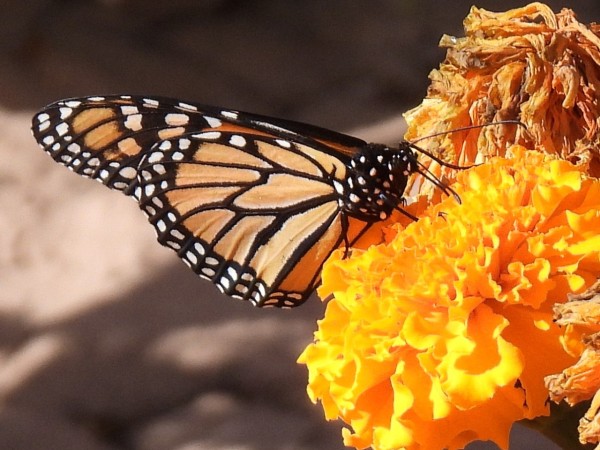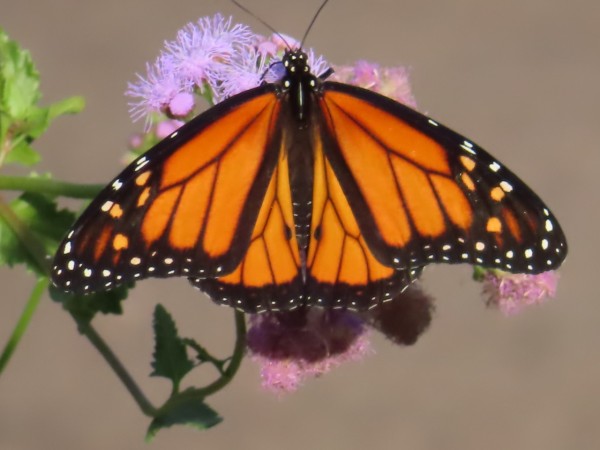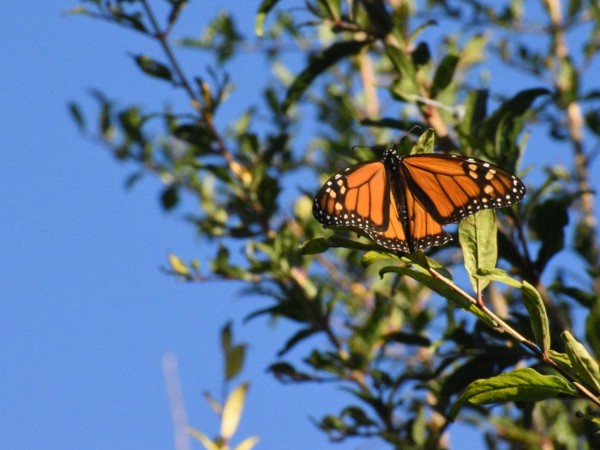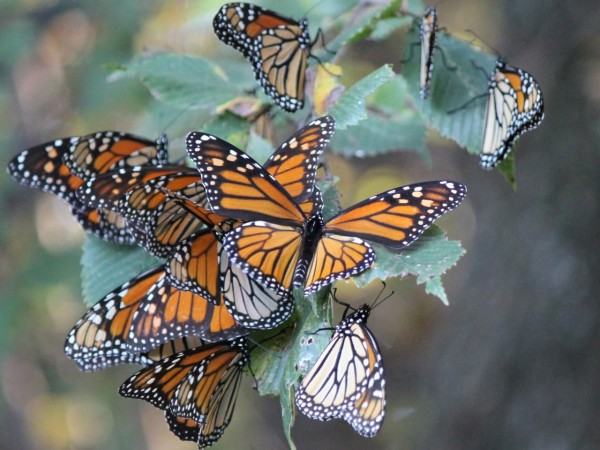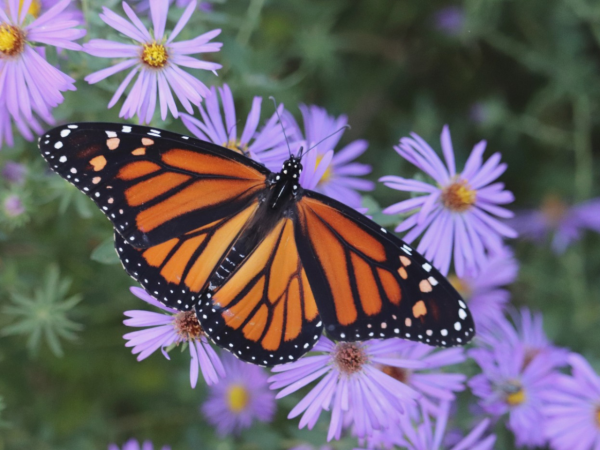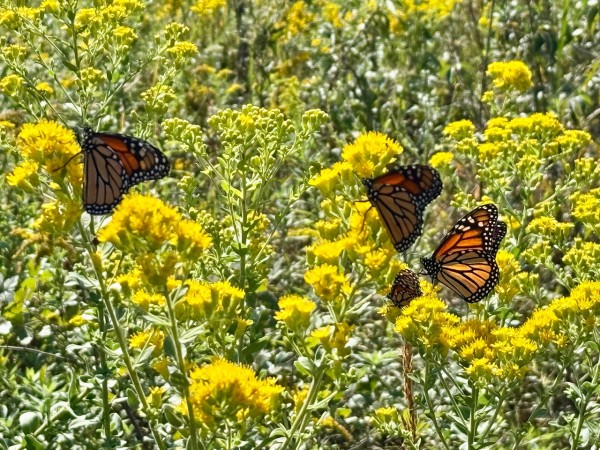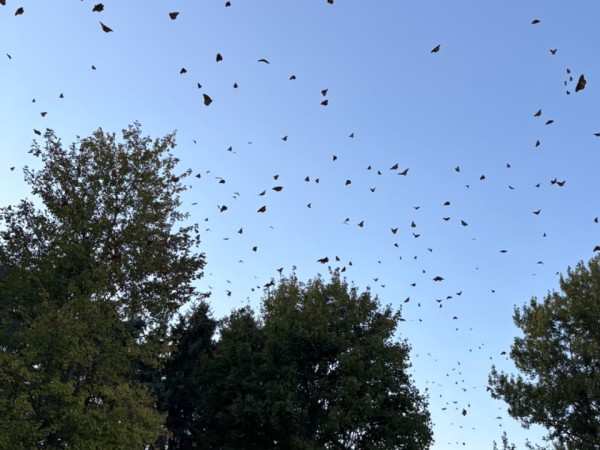Monarch Migration & Milkweed Phenology Project
Volunteers help track monarch butterfly migration and milkweed phenology across North America.
Help us track monarch migration and the presence of milkweed. Read through our protocols and then submit your observational reports.
Monarchs in the fall
During Fall migration, monarchs may be seen in large numbers exhibiting a variety of behaviors: nectaring to fuel up for their southward journey, roosting overnight in trees, or flying in a strong directional manner. Also during the fall, monarchs may still be observed mating and laying eggs, or seen individually around your gardens. We accept reports of all monarchs that you see, whether or not you think they are migrating.
Fall monarch report categories
- Monarch adult sighted - used for sightings of butterflies (unless PEAK or ROOST)
- Monarch fall roost - used for sightings of overnight roosts
- Monarch PEAK migration - used for sightings of atypically large numbers of monarchs for your area (e.g., dozens, hundreds), sighted at once or within a short time period
- Monarch egg sighted - used for sightings of eggs found on milkweed growing under natural conditions. Report egg total only once per week.
- Monarch larva sighted - used for sightings of larvae found on milkweed growing under natural conditions. Report larvae total only once per week.
- Monarch (other observations) - used for sightings of chrysalises, dead monarchs, or other unusual observations that don’t fit other categories.
As with all Journey North species tracked, reports are submitted for sightings of monarchs at a single location and reflect what is seen on the date listed in the report. Reports should include the number of monarchs sighted at a single location on the date reported. In the comments section, reports should also include the length of time you were observing, and behaviors (e.g., nectaring, egg laying, mating, flying directionally).
Reporting EXCEPTION: Because it is difficult to track individual eggs and larvae, daily counts of eggs and larvae within a milkweed patch tend to over-estimate the number of monarchs present. Instead, count eggs and larvae once during the week and submit one egg report and/or one larva report with the totals counted that day. This once-a-week sampling will give a better estimate of the true number of monarchs present in a particular milkweed patch.
Examples:
- If you are reporting monarchs observed at multiple locations, please submit separate reports, one for each location.
- If you are reporting monarch adults observed over several days, please submit separate reports, one report per day of observation. This helps us understand changes within the time period.
- In cases where activity significantly changes during the day of observation, a second report may be submitted for the same date. In this case, please note the time of day in the comments section.
- If you are reporting monarch eggs observed, count eggs once per week at a particular milkweed patch and submit one report representing the total count of eggs counted that week at that patch. For eggs observed at other locations, submit additional reports.
- If you are reporting monarch larvae observed, count larvae once per week at a particular milkweed patch and submit one report representing the total count of larvae that week at that milkweed patch. For larvae observed at other locations, submit additional reports.
Monarch adult sighted
Did you see a monarch butterfly?
Please report all monarch adults (ie. butterflies, not eggs or larvae) that you see, whether or not you think they are migrating. Reports should reflect the number of monarchs you observe at a single location, for a single day. In comments, include behaviors (e.g., nectaring, flying directionally, egg laying, mating), how you estimated the number sighted, and time spent observing.
- Date of sighting
- Location (move red bubble to location of sighting)
- Number of monarchs sighted
- If this number is estimated, please include in comments a description of how you estimated the number (add link to estimate tips, basic method)
- Comments
- Behaviors (eg., nectaring - include flower names; flying - include direction; mating; egg laying - include milkweed species)
- Estimation method for number sighted
- Time spent observing
- Photo
Submit daily reports as long as monarchs are present.
Monarch Fall Roost
Did you see a monarch roost? (see “Why Overnight Roosts?")
Migrating monarchs cluster together in trees at night, forming what is called a roost. A roost may have a handful of butterflies or more than you can count. Sometimes a large roost forms in several adjacent trees. If you see a roost, please report the number of monarchs in the roost along with habitat conditions that may indicate what attracted them to the area (e.g., are there nectar sources nearby, are they protected from the wind, etc). Because roosts are dynamic and often reform over multiple nights, please submit a new report for each day you observe the roost.
Fall roost reports should reflect the number of monarchs observed within a roost for a single night. In comments, include date roost formed (if known), how you estimated the number sighted, available nectar source(s), species of tree(s) in roost, and whether the monarchs are shielded from the wind in their location.
- Date of roost sighting (e.g., roost was observed forming on Sunday evening and dispersed Monday morning - submit SUNDAY in the date field).
- Location (move red bubble to location of roost sighting)
- Estimate of number of monarchs in roost.
- If roost is small, count the number of monarchs present
- If roost is large, estimate the number of monarchs present (See Tips for Estimating Monarchs)
- Comments (please include as much as is known):
- Date roost first formed, if known
- Unknown
- Known (mm/dd/yyyy)
- Please keep observing and reporting as long as roost is present. Submit one new report each day until the roost is no longer present.
- Tree species roost formed in
- Nectar resources nearby
- Yes, If so, what plants? Include an estimate of number of nectar plants or area covered by nectar plant species.
- None
- Were monarchs shielded from wind?
- Yes
- No
- Date roost first formed, if known
- Photo - required
Note: If roost remains more than one night, keep reporting daily as long as you see this roost.
Monarch PEAK migration
Did you see a PEAK migration event?
Monarch Fall migration is spectacular and also unpredictable. People often report seeing large numbers of monarchs flying in a clear “directional” flight, or seeing “hundreds of butterflies” nectaring in a field of flowers fuelling up for the long flight. And just as often, a person seeing a spectacular migration one day may not see a single monarch the next day in the same location. If you witness what seems to be a large number of monarchs for your area (i.e. dozens, hundreds), please report this sighting under PEAK Migration.
Reports should reflect the number of monarchs you observe at a single location, for a period of time during a single day.
Note: For reported numbers to be meaningful, we need to know the length of time you spent counting monarchs. Please include in the comments field the amount of time you counted monarchs (e.g., 15 minutes, one hour, several hours), preferably watching for at least 15 minutes. From this, we can then calculate a rate of flow.
Note: If you observe directional flight, please be sure to note the direction the monarchs are heading in the comments field.
- Date of sighting
- Location (move red bubble to location of monarch sighting)
- Number of monarchs sighted
- Comments
- For number estimates, please describe how you estimated the number
- Length of time observing and time of day
- Behavior (eg., flying - include direction monarch is heading and height above ground -see https://journeynorth.org/monarchs/featured/directional-flight; nectaring - include flower names if known)
- Area where monarchs were observed (e.g., large clover field, along southern shoreline of lake)
- Local Wind Conditions
- Wind Speed
- None to Light (<25 km/hr or 15 mph)
- Strong ( > 25 km/hr)
- Wind Direction (i.e., Wind direction is reported as direction the wind is coming FROM. For example, a N wind blows FROM the north to the south.)
- N, NW, W, SW, S, SE, E, NE
- Wind Speed
- Photo
Don't hesitate to report an event as "peak" if you believe it is. We review all sightings and will contact you with questions if necessary.
Breeding monarchs
Although we think of fall as the time for monarchs to migrate south, some monarchs continue to reproduce during this time. Your reports of monarch eggs and larvae can tell us when and where monarchs are breeding in the Fall.
Since eggs and larvae are relatively stationary, it is not necessary to report daily. In fact, daily counting can result in overestimates. Please count eggs and larvae once per week and report egg and larvae these counts once per week.
Additionally only report sightings of eggs and larvae found on milkweed growing outside exposed to natural conditions (e.g., sunlight, rainfall) and not protected from predators (i.e., no netting).
Monarch egg sighted
Did you see a monarch egg?
Only report sightings of eggs found on milkweed growing outside under natural conditions (see Journey North’s Goals in Tracking Monarchs).
- Date counted (i.e., date the eggs were counted, only once per week)
- Number of eggs counted once that week
- Comments - please include species of milkweed where eggs are found.
- Photo
Monarch larva sighted
Did you see a monarch larva?
Only report sightings of larvae found on milkweed growing outside under natural conditions (see Journey North’s Goals in Tracking Monarchs).
If you are raising larvae from collected eggs, do not report these as Monarch Larva Sighted.
- Date counted (i.e., date the larvae were counted, only once per week)
- Number of larvae counted once that week
- Comments - please include species of milkweed where larvae are found.
- Photo
Monarch (other observations)
- Date reported
- Number of monarchs sighted
- Comments - please describe (e.g., chrysalis, dead monarch, etc)
- Photo
TERMS
(Definitions from The Xerces Society)
Cluster: more than two adjacent butterflies with closed wings
Loners: two (adjacent) or fewer butterflies with closed wings not associated with a cluster
Sunners: wings are open and temperatures exceed 55° F (likely that the sunning butterflies flew from their cluster to the sunning location)
Fliers: estimated number of butterflies in flight
Wind direction: direction the wind is coming FROM
Winter (December, January, February) reporting protocols
If you live in the southwest and southeast of the U.S., stay vigilant. Monarchs are still being observed periodically in these areas. Please report your monarch and milkweed observations to Journey North. Explore Journey North maps to learn where monarchs and milkweed are being observed.
If you live in the Gulf states of Texas, Louisiana, Mississippi, Alabama, and Florida as well as Georgia, South Carolina, and North Carolina, Journey North is looking for volunteers to monitor monarch activity and the location of milkweed in these states. Please use the following reporting categories:
Spring reporting protocols
Report: Monarch adult (FIRST sighted)
- What: Did you see your first migrating monarch of the spring season? The first arrivals of monarchs to their breeding range occur from February to June depending on your location. Let us know when you see your first adult migrating monarch. Report the number of monarchs observed at a single location.
- Comments: What behaviors did you observe, such as flying, nectaring upon what flower species, mating, basking in shade or sun?
- Frequency: Once per spring season. Only one first spring observation is accepted for an individual observer reporting from a single location.
- Photos: Always welcome. Photos provide a voucher for observational reports.
Report: Milkweed (FIRST sighted)
- What: Did you see a newly emerged milkweed? Observations of the first milkweed emergence occur from February to June depending on your location.
- Comments: If known, please report (1) the species milkweed, (2) the height of the emergent plant (emergent: 2-5 inches; leaves present: 5 inches; a few flowers present with budding just starting; fruiting with pods present; leaves yellowing). Also, please let us know the size of the milkweed patch (few – 1-15 stems; denser patch – 15-50 stems; abundant patch – 50-100 stems; very abundant – 100+ stems). Frequency: Once per spring season. Only one first spring observation is accepted for an individual observer reporting from a single location.
- Photos: Always welcome. Photos provide a voucher for observational reports.
Report: Monarch egg (FIRST sighted) and/or monarch larva (FIRST sighted)
- What: Did you your monarch egg and/or larvae for the spring season?
- Comments: If known, please report the species of milkweed you observed the egg(s) and/or larvae on.
- Frequency: Once per spring season. Only one first spring observation is accepted for an individual observer reporting from a single location.
- Photos: Always welcome. Photos provide a voucher for observational reports.
Report: monarch adult sighted
- What: Where are monarchs? Report all monarch adults after reporting your first observation of a migrating monarch. Report the number of monarchs observed at a single location.
- Comments: What behaviors did you observe, such as flying, nectaring upon what flower species, mating, basking in shade or sun?
- Frequency: Report once a week when monarchs are present. Occasional reporting is welcome.
- Photos: Always welcome. Photos provide a voucher for observational reports.
Report: Monarch egg sighted and/or monarch larva sighted
- What: Is breeding happening? Report the presence of monarch egg(s).
- Frequency: Report once a week when monarch eggs are present. It is difficult to track individual eggs and larvae. Daily counts of eggs and larvae are not necessary. Noting the presence of monarch egg(s) is sufficient. If you want to count monarch egg(s), please count once during the week, and submit one report with the totals counted that day. Occasional reporting is welcome.
- Comments: If known, please report the species of milkweed you observed the egg(s) and/or larvae on.
- Photos: Always welcome. Photos provide a voucher for observational reports.
Report: Monarch (other observations)
- What: Observations of interesting behaviors including mating, laying eggs, nectaring (please let us know flowering plant species if known), basking in the sun, chrysalis, and deceased monarchs.
- Frequency: Report once a week. Occasional reporting is welcome.
- Photos: Always welcome. Photos provide a voucher for observational reports.
Report: Milkweed sighted
- What: Where are milkweed plants? Report milkweed presence across the landscape.
- Comments: If known, please report (1) the species milkweed, (2) the height of the emergent plant (emergent: 2-5 inches; leaves present: 5 inches; a few flowers present with budding just starting; fruiting with pods present; leaves yellowing). Also, please let us know the size of the milkweed patch (few – 1-15 stems; denser patch – 15-50 stems; abundant patch – 50-100 stems; very abundant – 100+ stems). Frequency: Report once a week. Occasional reporting is welcome.
- Photos: Always welcome. Photos provide a voucher for observational reports.
Subscription information: migration news
Interested in learning more about monarch butterflies? Subscribe to Journey North Monarchs & Milkweed News Updates. Click the "subscribe" button in the top-right corner of any published news update. Beginning in March, these news updates will be delivered to your inbox twice a month.
Letters from the field
For news of the western monarch population, Catch up on her all news updates from Ms. Gail Morris, Southwest Monarch Study. previous news updates:
Interested in hearing the news from the Monarch Butterfly Biosphere Research in the States of Michoacán and Mexico, Mexico, read Ms. Romero's reports from Sierra Chincua and El Rosario Sanctuaries:
Letters From The Field: Archive Collection: Ms. Estela Romero.
For Ms. Romero's posts describing her work with the Symbolic Migration Project and other environmental educational programming, please refer to her weekly blog posts.

